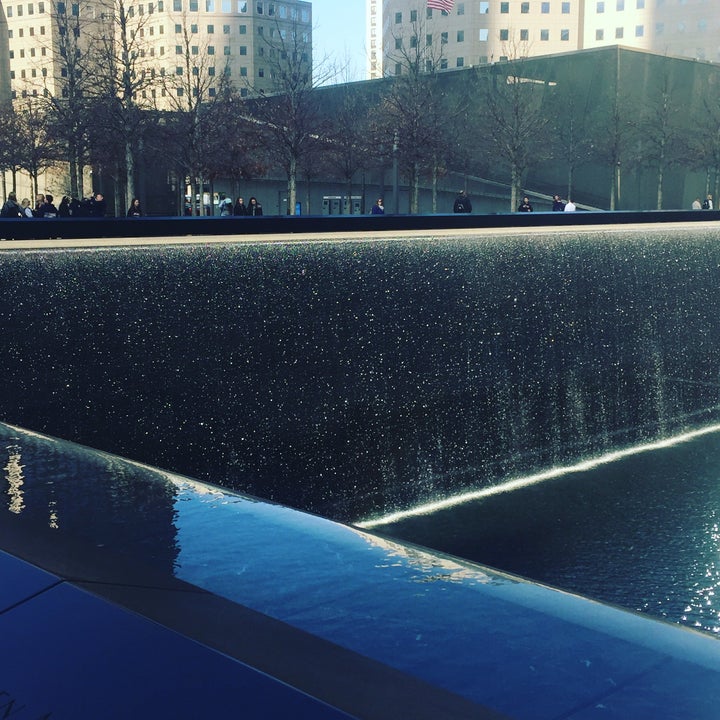
She had a business suit on, her hair all askew. This woman stood there for what seemed like minutes and then she held down her skirt and jumped off the ledge. I thought, how human, how modest, to hold down her skirt before she jumped. I couldn’t look anymore. James Gilroy, a neighbor, at the National September 11 Memorial & Museum in NYC.
For a moment, that woman is me. The vision is seared in my mind, unshakable. Would I have had her courage? Or, would I have been paralyzed with hope that we would be rescued on the upper floors of the Twin Towers? The terror is palpable, even now. The jump. Not suicide: choice.
The fall was said to take about 10 seconds at approximately 125 mph. If a person dove head first, their body could fall as fast as 200 mph. Bodies that fated day were not broken, but obliterated. Having never jumped out of a plane, I couldn’t say what kind of fear or momentary exhilaration one would feel, if only for a moment. I want to believe there was an expedient loss of consciousness, but there’s a chance the speed wasn’t fast enough to guarantee anything other than death upon impact.
It’s only now I learn of the great controversy over the jumpers of 9/11. I never realized it was a secret that officially these “jumpers” don’t really exist, the 200 or more of them, as estimated by USA Today. All of the 2,753 people who perished in the attack that collapsed the Towers were said to have died from ‘blunt force impact’. Years later, over 1,000 have yet to be identified by remains. A spokesperson from the medical examiner has said that there can’t be jumpers because people didn’t go to work in the morning intending to commit suicide. British newspapers have countered that some of the most horrifying images of the tragedy have been silenced by the American media.
Two reasons are proposed. First is that in that period of stealth American patriotism, to admit to the deliberate jump as a suicide would equate to lack of courage. The other reasons is sacrilege. To commit suicide rather than accept the fate of God would, in some religions, not only be shameful but reason to condemn the person to Hell, inflicting even more tragedy and pain on their loved ones. Understandably, the images are so horrifying, some perhaps find some solace in the tragic truth that their loved ones were killed by terrorists. But, if not for the jumpers in the North Tower, some believe the people in the South Tower, which collapsed first, would not have taken the attack seriously enough to get out.
Since I visited that small and discreet room in 9/11 Memorial Museum, the image of that woman stays with me. I carry her in my heart to remind me that if I can’t be courageous in my life for me, then at least I can do it for her. I think who I was in 2001, 31 and sitting in my office nearly a hundred miles away, years beyond my first out-of-college job at Morgan Stanley in NYC. The ‘blue suit life’ had felt stifling to me so I decided to go to law school. In my first round of applications, I only applied to the best schools, getting rejected by all of them. Next time, I applied to schools in places I wanted to live. Law school in New Orleans was one of the most expensive, but best decisions I’ve made. I wondered if I’d decided to stay in New York, would I have been working in Morgan’s Twin Tower location?
I want to believe this woman who jumped was like me, and I that I too could make such a courageous decision. No doubt in my mind that she was smart and tough. Like me, she must have had a side to her that she wouldn’t allow people to see at work: she was fun when she wasn’t being serious; she had really good close girlfriends who kept her honest; and, marriage wasn’t quite yet on her radar. She is missed, even by those who only knew her peripherally. She could not have realized her impact, even now on me, a stranger, 15 years later.
My own personal connections to September 11 surround serendipity and survival. My husband, scheduled to go to NYC that morning, got a call and turned around. My former boss had meetings cancel in Windows of the World the evening before. My father’s best friend’s son, let go from Cantor Fitzgerald months before, had survived, but many of his friends that he’d worked with perished. I met a woman who’d moved out to the Hamptons soon after and described running for her life blindly through the ash. But then there’s Steve, the NYC fireman, stationed in SOHO, a friend of a friend that we went skiing with in Vermont only once. His was one of the first firetrucks on-sight; he didn’t make it.
I was surprised at my emotional reaction and resonance at the museum. I was in meetings downtown on St. Patrick’s Day and when I walked by there was no line. The beautiful and peaceful fountains are serene and I expected the museum to be the same. Walking through with all the tourists, I felt my connection deepen. Reading the quote about the woman pinged my heart and wouldn’t let go. Maybe it’s because when I’m nervous, I do exactly what she did before she stepped off the North Tower. The smoothing of my skirt is both precise and calming, allowing me to carry on with what I need to do.
I choose to believe she didn’t care about modesty or anything else having to do with her skirt, hair or shoes at that moment with wind, flames and debris swirling around her. I close my eyes and feel her trying to pull herself together, gather every bit of strength she had, making one last courageous decision.
In this small way, on the 15 anniversary, I hope to honor her and all the others who died that day.
